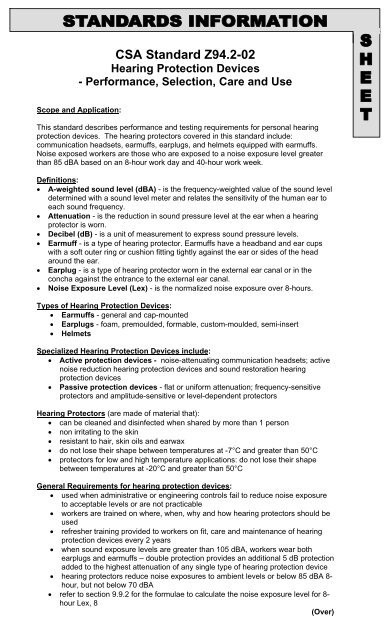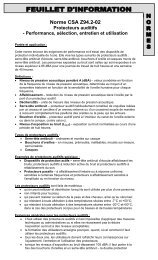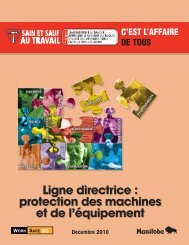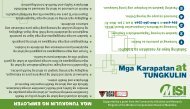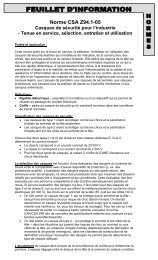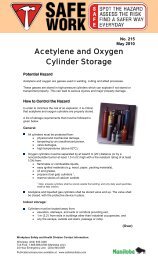CSA Standard Z94.2-02 - SAFE Manitoba
CSA Standard Z94.2-02 - SAFE Manitoba
CSA Standard Z94.2-02 - SAFE Manitoba
You also want an ePaper? Increase the reach of your titles
YUMPU automatically turns print PDFs into web optimized ePapers that Google loves.
<strong>CSA</strong> <strong>Standard</strong> <strong>Z94.2</strong>-<strong>02</strong><br />
Hearing Protection Devices<br />
- Performance, Selection, Care and Use<br />
Scope and Application:<br />
This standard describes performance and testing requirements for personal hearing<br />
protection devices. The hearing protectors covered in this standard include:<br />
communication headsets, earmuffs, earplugs, and helmets equipped with earmuffs.<br />
Noise exposed workers are those who are exposed to a noise exposure level greater<br />
than 85 dBA based on an 8-hour work day and 40-hour work week.<br />
Definitions:<br />
• A-weighted sound level (dBA) - is the frequency-weighted value of the sound level<br />
determined with a sound level meter and relates the sensitivity of the human ear to<br />
each sound frequency.<br />
• Attenuation - is the reduction in sound pressure level at the ear when a hearing<br />
protector is worn.<br />
• Decibel (dB) - is a unit of measurement to express sound pressure levels.<br />
• Earmuff - is a type of hearing protector. Earmuffs have a headband and ear cups<br />
with a soft outer ring or cushion fitting tightly against the ear or sides of the head<br />
around the ear.<br />
• Earplug - is a type of hearing protector worn in the external ear canal or in the<br />
concha against the entrance to the external ear canal.<br />
• Noise Exposure Level (Lex) - is the normalized noise exposure over 8-hours.<br />
Types of Hearing Protection Devices:<br />
• Earmuffs - general and cap-mounted<br />
• Earplugs - foam, premoulded, formable, custom-moulded, semi-insert<br />
• Helmets<br />
Specialized Hearing Protection Devices include:<br />
• Active protection devices - noise-attenuating communication headsets; active<br />
noise reduction hearing protection devices and sound restoration hearing<br />
protection devices<br />
• Passive protection devices - flat or uniform attenuation; frequency-sensitive<br />
protectors and amplitude-sensitive or level-dependent protectors<br />
Hearing Protectors (are made of material that):<br />
• can be cleaned and disinfected when shared by more than 1 person<br />
• non irritating to the skin<br />
• resistant to hair, skin oils and earwax<br />
• do not lose their shape between temperatures at -7°C and greater than 50°C<br />
• protectors for low and high temperature applications: do not lose their shape<br />
between temperatures at -20°C and greater than 50°C<br />
General Requirements for hearing protection devices:<br />
• used when administrative or engineering controls fail to reduce noise exposure<br />
to acceptable levels or are not practicable<br />
• workers are trained on where, when, why and how hearing protectors should be<br />
used<br />
• refresher training provided to workers on fit, care and maintenance of hearing<br />
protection devices every 2 years<br />
• when sound exposure levels are greater than 105 dBA, workers wear both<br />
earplugs and earmuffs – double protection provides an additional 5 dB protection<br />
added to the highest attenuation of any single type of hearing protection device<br />
• hearing protectors reduce noise exposures to ambient levels or below 85 dBA 8-<br />
hour, but not below 70 dBA<br />
• refer to section 9.9.2 for the formulae to calculate the noise exposure level for 8hour<br />
Lex, 8<br />
(Over)
(cont’d)<br />
• audiometric testing is required to monitor the hearing of exposed workers and to<br />
determine the effectiveness of the hearing protection device worn<br />
Fit, Care and Use of Hearing Protection Devices:<br />
• proper fitting technique recommended by the manufacturer for the selection of a<br />
hearing protection device<br />
• the hearing protection device must make a tight seal in the ear canal or against<br />
the side of the head<br />
• jewellery, hair or some types of clothing worn may interfere with the seal<br />
Packaging information must include:<br />
• attenuation Grade/Class of the hearing protection device<br />
• the device is tested according to ANSI <strong>Standard</strong> S12.6, 1997, Method for the<br />
Measurement of Real-Ear Attenuation of Hearing Protectors<br />
• a warning that a properly fitted hearing protection device will provide full<br />
attenuation<br />
• the manufacturer’s information<br />
Signs in the Workplace:<br />
• required in areas where noise levels are greater than 85 dBA<br />
• a clear visible warning sign must be located at all entrances into the workplace<br />
• text on the sign shall be in English and French and in the predominant language<br />
of the workplace<br />
• signs shall include a pictogram, according to <strong>CSA</strong> <strong>Standard</strong> CAN/<strong>CSA</strong>-Z321-96,<br />
Signs and Symbols for the Workplace<br />
This bulletin contains a summary of excerpts taken from the <strong>Standard</strong>, for general<br />
information purposes only. This bulletin is not reflective of the complete<br />
requirements that the <strong>Standard</strong> prescribes.<br />
Note: <strong>Manitoba</strong> Regulation M.R. 217/2006 Section 1.4 inconsistency:<br />
If there is an inconsistency between this regulation and a requirement contained<br />
in a publication, code or standard referenced in this regulation, the provisions in<br />
this regulation prevail.


